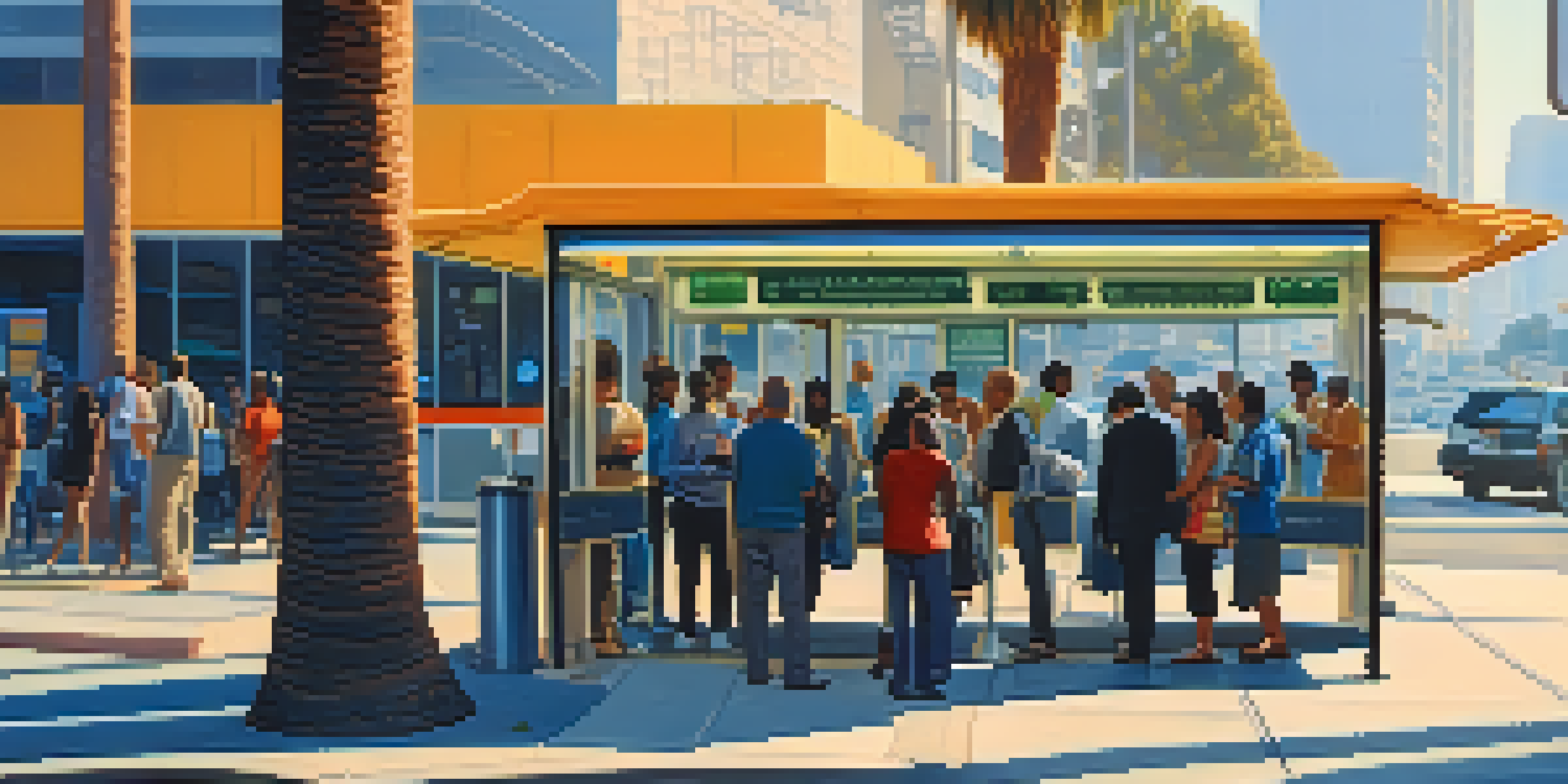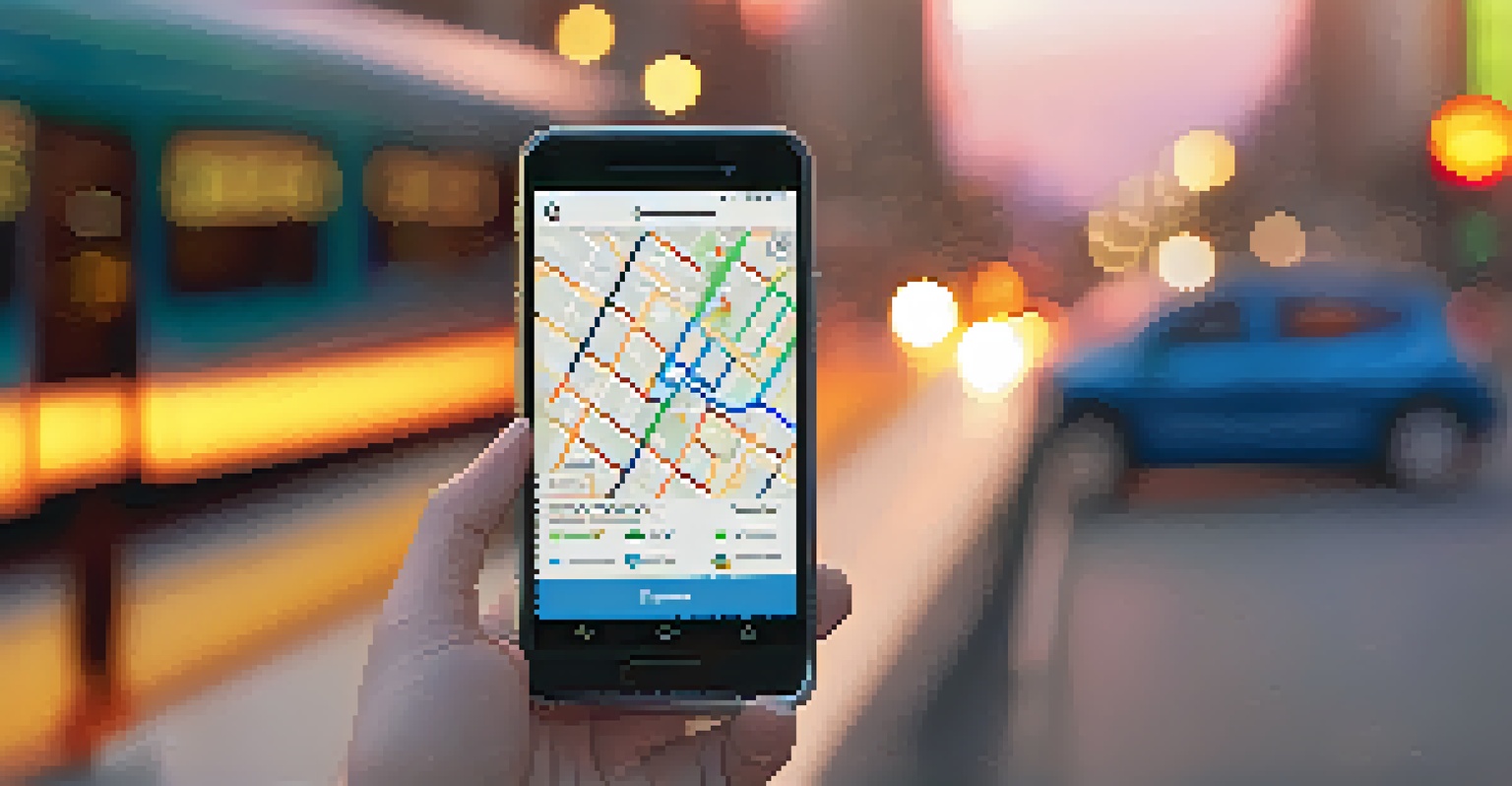Mobile Apps: Enhancing Public Transportation Experiences in LA

The Rise of Mobile Apps in Public Transportation
In recent years, mobile apps have revolutionized the way we navigate public transportation, especially in a bustling city like Los Angeles. With the click of a button, riders can access real-time information about routes, schedules, and delays. This shift not only enhances convenience but also encourages more people to consider public transit as a viable option for commuting.
Technology is best when it brings people together.
Apps like Metro's official platform and third-party services have made it easier than ever to plan trips, track buses or trains, and even pay for fares directly from a smartphone. This technological advancement has significantly improved the reliability and user-friendliness of the public transport system. As a result, commuters can make informed decisions, reducing wait times and frustration.
Moreover, these apps often include features like route optimization and service alerts, providing users with personalized experiences. This means that whether you're a local or a visitor, navigating the complexities of LA's public transport has become a seamless process, ultimately enhancing the overall commuting experience.
User-Friendly Features That Make a Difference
Mobile apps designed for public transportation come loaded with user-friendly features. For example, many apps offer trip planning tools that allow users to input their starting point and destination, displaying the best routes available. This functionality is particularly beneficial for those unfamiliar with the city's layout or public transit options.

Additionally, features like real-time tracking give users the ability to see exactly when their bus or train will arrive. Imagine standing at a bus stop on a chilly morning, and instead of guessing when your ride will show up, you can check an app that tells you it'll be there in just three minutes. This level of accessibility not only enhances the experience but also instills confidence in choosing public transportation.
Mobile Apps Enhance Transit Experience
Mobile apps provide real-time information and user-friendly features, making public transportation more accessible and reliable.
Another great feature is the integration of payment options, allowing users to purchase tickets directly through their phones. This eliminates the hassle of carrying cash or waiting in long lines at ticket machines, making public transit more appealing to a broader audience.
Promoting Accessibility for All Riders
One of the key benefits of mobile apps in public transportation is their potential to improve accessibility for all riders. Many apps include features designed specifically for individuals with disabilities, such as audio announcements and detailed information on wheelchair-accessible routes. This ensures that everyone can navigate the transit system with ease.
Public transportation is a lifeline for communities, linking people to opportunities and resources.
Moreover, by providing multilingual support, these apps cater to the diverse population of Los Angeles. Riders can easily switch between languages, making information accessible to non-English speakers. This inclusivity not only enhances the user experience but also promotes a sense of community among transit riders.
By utilizing technology to bridge the gap, mobile apps empower all individuals to make the most of public transportation options. The result is a more cohesive and supportive transit environment where everyone feels welcome and included.
Reducing Traffic Congestion Through Smart Solutions
One of the most significant challenges Los Angeles faces is traffic congestion. However, mobile apps are playing a crucial role in mitigating this issue by encouraging the use of public transportation. As more people turn to these apps for their commuting needs, the number of vehicles on the road decreases, easing traffic flow.
In addition, some apps promote carpooling and ridesharing options, further reducing the number of individual cars on the road. For example, riders can connect with others heading in the same direction, which not only alleviates congestion but also fosters a sense of community among commuters.
Promoting Sustainability through Transit
By encouraging public transit use, mobile apps help reduce traffic congestion and lower carbon emissions, contributing to a greener future.
By integrating smart solutions into public transportation, mobile apps contribute to a more sustainable urban environment. The more we embrace these technologies, the closer we get to a future where traffic congestion is significantly reduced, making LA a more livable city.
Environmental Impact: A Greener Future
With rising concerns about climate change, the shift towards mobile apps in public transportation also aligns with the need for greener solutions. By encouraging the use of public transit over personal vehicles, these apps help lower carbon emissions and reduce our overall environmental footprint. This is particularly crucial in a sprawling city like Los Angeles, where air quality has long been a concern.
Additionally, many mobile apps provide insights into the environmental benefits of public transit, helping users understand how their choices impact the planet. For instance, riders might see information indicating how many pounds of CO2 they’ve saved by opting for a bus instead of driving their car.
As we become more environmentally conscious, mobile apps play a significant role in promoting sustainable travel. By making public transportation more accessible and appealing, these apps contribute to a greener future for Los Angeles and beyond.
Community Engagement and Feedback Channels
Mobile apps not only streamline the public transportation experience but also serve as platforms for community engagement. Many apps include feedback features, allowing riders to share their experiences and suggest improvements. This two-way communication fosters a sense of ownership and responsibility among users.
Transit authorities can leverage this feedback to make informed decisions about service improvements or new initiatives. For instance, if a significant number of users report delays on a particular route, it can prompt a review and necessary adjustments, ultimately enhancing service reliability.
Community Engagement Boosts Ridership
Feedback features in mobile apps foster community involvement, allowing riders to suggest improvements and enhancing overall service reliability.
Moreover, engaging with the community through apps can lead to increased ridership. When users feel heard and valued, they are more likely to continue using public transportation and advocate for its benefits within their social circles, creating a positive feedback loop.
The Future of Mobile Apps in Public Transit
As technology continues to evolve, the future of mobile apps in public transportation looks promising. Innovations such as artificial intelligence and machine learning are paving the way for even more personalized experiences. Imagine an app that learns your commuting habits and suggests the best routes based on real-time traffic conditions and historical data.
Furthermore, the integration of augmented reality (AR) could revolutionize how riders navigate transit systems. With AR features, users could point their phones at a train station or bus stop to receive instant information about upcoming departures, nearby amenities, or even directions to their final destination.

The potential for growth and enhancement is vast, and as cities like Los Angeles continue to invest in their public transportation infrastructure, mobile apps will undoubtedly play a central role in shaping the commuting experience. With ongoing advancements, the future of public transit looks brighter than ever.